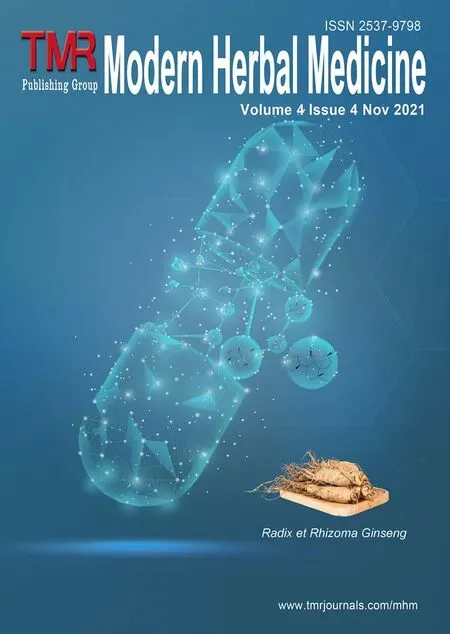Network pharmacology-based analysis on bioactive compounds and mechanisms in Yiqifumai formula in the treatment of heart failure
2021-11-04HerongCuiKedianChenXiaoyuZhangHongcaiShang
Herong Cui , Kedian Chen, Xiaoyu Zhang , Hongcai Shang *
1 Dongzhimen Hospital, Beijing University of Chinese Medicine, Beijing 100700, China.
2 School of Chinese Pharmacy, Beijing University of Chinese Medicine, Beijing 102488, China.
Abstract Objective To predict the main bioactive components and potential mechanisms of Yiqifumai formula on heart failure by network pharmacology.Methods The bioactive compounds of Yiqifumai formula were screened by TCMSP database.The target genes of heart failure were obtained by entering PharmMapper and GeneCards database.R 3.6.3 was used to intercept intersection network for candidate targets.The network of “drug-compound-target-disease” was established via Cytoscape 3.7.2 and STRING platform.The DAVID database was used for GO enrichment analysis and KEGG pathway based on the candidate targets.Results Eleven key compounds (such as Schizandrin C, Gomisin G, ginsenoside rh2, Ruscogenin etc.,), 426 non-repeated targets and 382 heart failure targets were obtained from Yiqifumai formula.There were 565 GO items (P< 0.05), among which 412 were biological process (BP) items, 63 were cell components (CC) items, and 93 were molecular function (MF) items.One hundred and seventeen signal pathways were enriched by KEGG pathway (P< 0.05).Conclusion The bioactive compounds in Yiqifumai formula can play the “multi-target” role of enhancing resistance and eliminating pathogenic factors via regulation of angiogenesis and immune in the treatment of heart failure.
Keywords:Network pharmacology, Yiqifumai formula, Heart failure, Mechanism, Bioactive compound
Background
Heart failure is the most common cardiovascular factor for hospitalized elderly patients over 60 years old, of which the five-year mortality is equivalent to that of malignant tumors [1].The total medical cost is expected to increase to 53.1 billion US dollars by 2030 [2-3].Reports have shown that patients with previous cardiovascular diseases are more likely to suffer adverse outcomes related to COVID-19.That is because patients with heart failure have limited cardiac and respiratory reserves, which cannot tolerate cardiac pressure caused by infection.Original vascular congestion will programmatically induce endothelial cell activation, pro-inflammatory and refinement of oxidative mediators, resulting in increased concentrations of endotoxin and cytokines, which brings challenges to the medical management of patients with heart failure [4].The existing evidencebased regimen mainly uses the combination of renin angiotensin aldosterone system inhibitors, receptor blockers and other drugs.This only takes effect in the best treatment period, of which the long-term medication will lead to adverse reactions such as deterioration of renal function and hyperuricemia.Thus, it is gradually transformed into multidisciplinary overall regimen for better efficacy and safety [4-5].
“What are the mechanisms of traditional Chinese medicine (TCM) on immune?” was selected into the top 10 scientific questions with guiding effect on scientific development by China Association for Science and Technology in 2020.Through the multilevel and multi-target characteristics such as supplementing Qi, warming Yang, promoting blood circulation etc., Chinese medicines could regulate immune, alleviate clinical symptoms, improve the quality of life, and reduce mortality and rehospitalization rate of patients with heart failure.Yiqifumai formula, a representative TCM formula, is originated from the Shengmai formula.It is composed of Hongshen (Ginseng Radix Et Rhizoma Rubra) 10 g, Maidong (Ophiopogonis Radix) 30 g and Wuweizi (Schisandrae Chinensis Fructus) 15 g and has controllable quality (z20060463) and remarkable effects on cardiovascular diseases.Previous studies have shown that Yiqifumai formula has recognized therapeutic value by effectively improving state of patients with heart failure.Further, there is few reports of serious adverse reactions since it has been on the market, meanwhile it has obvious advantages in pharmacoeconomics.However, the specific mechanisms of Yiqifumai formula on heart failure remain to be further explained [6-8].
Based on the theory of system biology, network pharmacology is combined with pharmacology and computer technology to realize the comprehensive analysis on biological network and mechanisms, which is especially suitable for Chinese medicines and TCM formulae characterized by multi-component, multitarget, and multi-pathway [9].Based on this, this manuscript intends to screen the targets of Yiqifumai formula in regulating heart failure by network pharmacological methods, and analyze the main bioactive compounds and potential mechanisms, in order to provide basis for the clinical application and subsequent research of Yiqifumai formula.
Materials and Methods
Acquisition of drug targets, disease targets and common targets
TCMSP was used to predict the absorption, distribution, and metabolism of chemical components in Yiqifumai formula.The active components of Hongshen, Maidong, and Wuweizi were obtained from TCMSP database.In this study, the pharmacokinetics of compounds were screened by oral bioavailability (OB) and drug similarity (DL), and OB ≥ 30 % and DL ≥ 0.18 were used as domain values for screening key compounds with high activity.As a result, 11 key compounds of Hongshen (4), Maidong (11), and Wuweizi (6) were collected as drug targets.All drug targets were searched in the Uniport database, set the species as human, in order to obtain the uniport names of the target standard.Enter the keyword “heart failure” in the Genecards database to obtain the disease targets of heart failure, and conduct Wayne analysis with the drug target screened above to obtain the common targets.
Establishment of drug-disease-target interaction network for key target screening
In order to explain the effects of Yiqifumai formula on heart failure, the relationship between the common target and key compounds is drawn applying Cytoscape 3.7.2 software.In this network diagram, the key compounds and common targets are represented by nodes, and the interaction relationship between nodes is represented by edges.Further, the protein-protein interaction network (PPI network) of the target group was constructed through STRING, the protein-protein interaction analysis platform, to analyze the interaction between the key components and common targets.A total of 382 target proteins from Hongshen, Maidong, Wuweizi and heart failure were imported into the STRING database.Study species select human beings.And the target protein PPI network was constructed to obtain the protein interaction relationship.The protein relationship with a score > 0.9 was imported as the obtained TSV file into Cytoscape 3.7.2 software.The network topology attributes were analyzed by using the “network analysis” function, and the target proteins with node degree distribution and betweenness centrality above the average value were selected as the key targets.
GO and KEGG enrichment analysis
The key targets of Yiqifumai formula on heart failure were executed to the enrichment of biological process (BP), molecular function (MF) and cell component (CC) in GO, and the items with correctionP≤ 0.05 were screened by referencing STRING database.The key targets of Yiqifumai formula on heart failure were enriched and analyzed by KEGG pathway, and the items with correctionP≤ 0.05 were screened by quoting STRING database.R 3.6.3 software was used to draw histogram and Bubble Diagram to study the possible action pathways of key targets and their pharmacological significance.
Database
The main databases used in this study are shown as Table 1.
Results
Establishment of target library of Yiqifumai formula on heart failure
Eleven key compounds with high activity and 426 non-repeated target information in Hongshen, Maidong, and Wuweizi were collected through the screening conditions of oral bioavailability (OB ≥ 30 %) and drug similarity (DL ≥ 0.14) (Figure 1).The target information of the above active compounds was queried through TCMSP database, and the gene ID in Hongshen, Maidong, and Wuweizi was annotated through UniProt.A total of 13589 targets related to heart failure was found in Genecard database, and 382 common targets were found in Yiqifumai formula, as shown in Table S1.
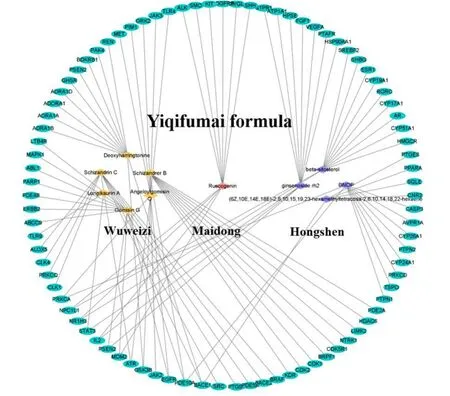
Figure 1.Drug-compound-target network of Yiqifumai formula on heart failure.
Target protein interaction and key target analysis
PPI analysis was conducted on the string platform to obtain the target PPI network diagram (Figure 2).A total of 375 targets have participated in the PPI network and 7 target proteins did not participate in protein interaction.The average degree value of PPI network is 27.89866667 and the average medium value is 0.003689199, and 69 key targets with degree value and medium number exceeded the average value.According to the results of PPI analysis, the bioactive compounds were analyzed based on above key targets, such as Schizandrin C, Gomisin G, ginsenoside rh2, Ruscogenin and so on (see Table 1 and Table S2).It is suggested that these compounds may participate in part of mechanisms of Yiqifumai formula on heart failure.
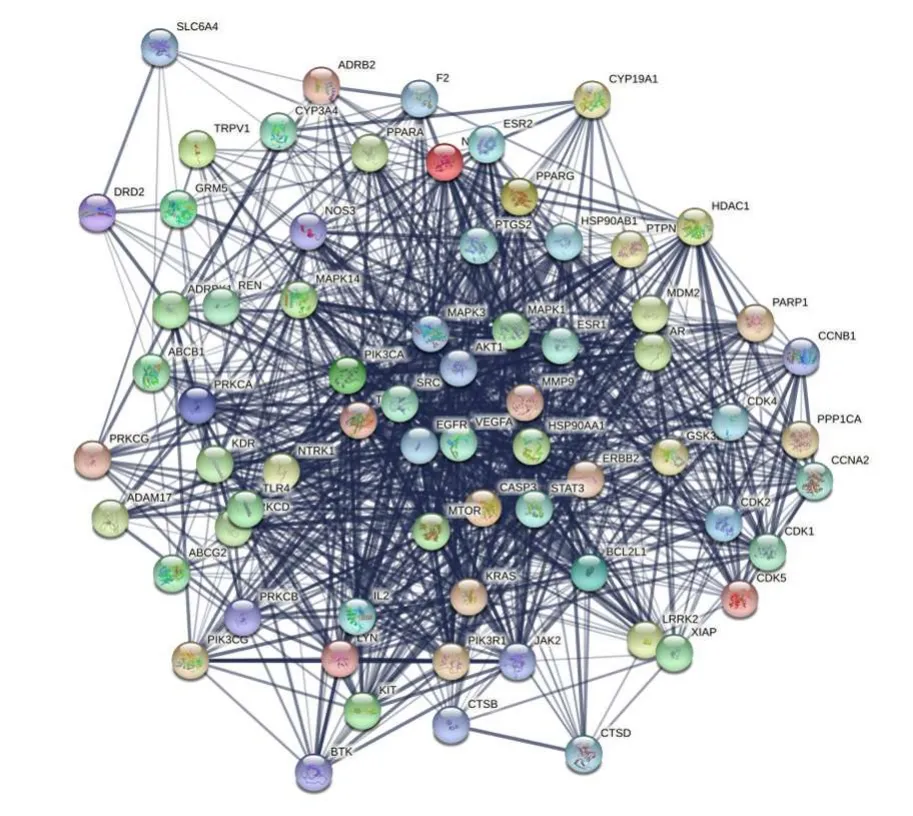
Figure 2.Core protein interaction network diagram of Yiqifumai formula on heart failure
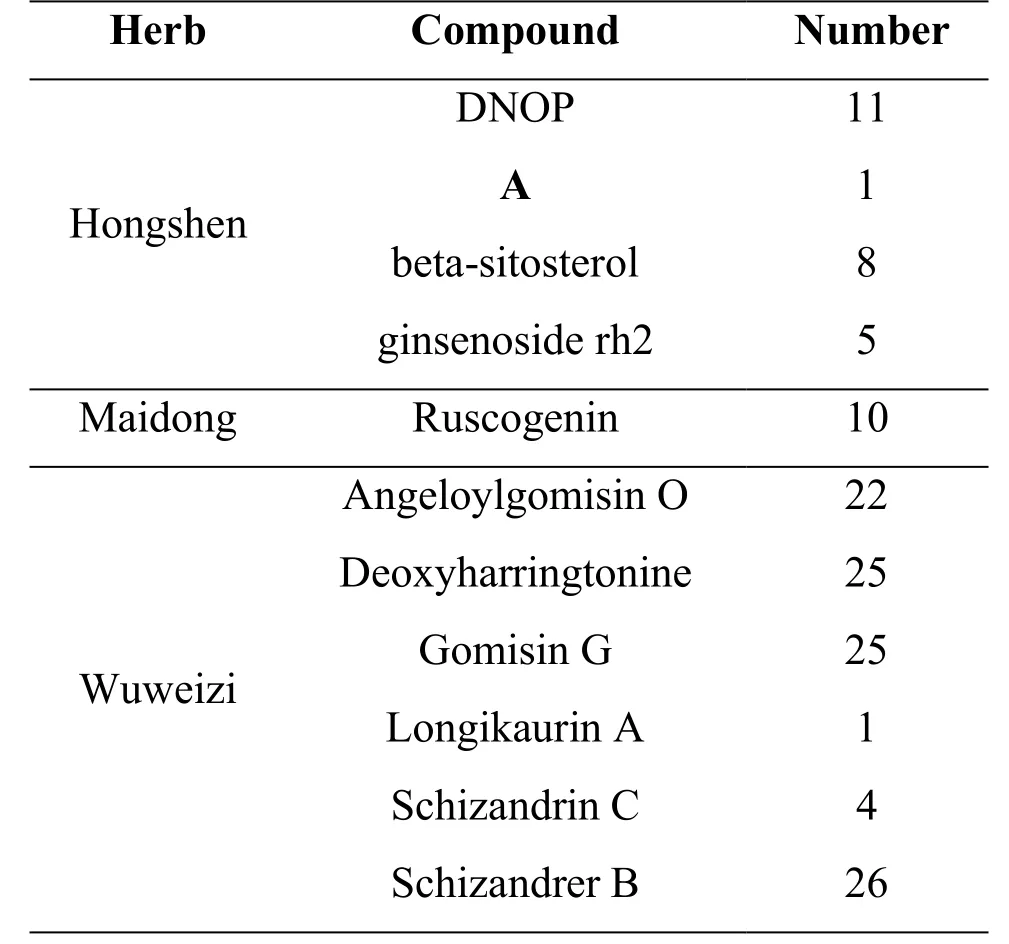
Table 1.Number of key target links of bioactive compounds in Yiqifumai formula on heart failure

Table 1.Database information
GO bioanalysis based on key targets
DAVID 6.8 platform was used to enrich the go biological process and visualize the key targets of Yiqi Fumai formula affecting heart failure.The effect of Yiqifumai formula on heart failure involves 565 biological processes (Table S3), including 412 BP, 63 CC and 93 MF.Select the top 20 of the obtained BP, MF and CC data results respectively for visual processing as shown in Figure 3.According to the target enrichment results of GO bioanalysis, these targets mainly involve histone H3-T6 phosphorylation and other processes in BP, phosphatidylinositol 3-kinase complex, class IA and other processes in CC and RNA polymerase II transcription factor activity, estrogenactivated sequence-specific DNA binding and other processes in MF.

Figure 3.GO analysis of Yiqifumai formula on heart failure
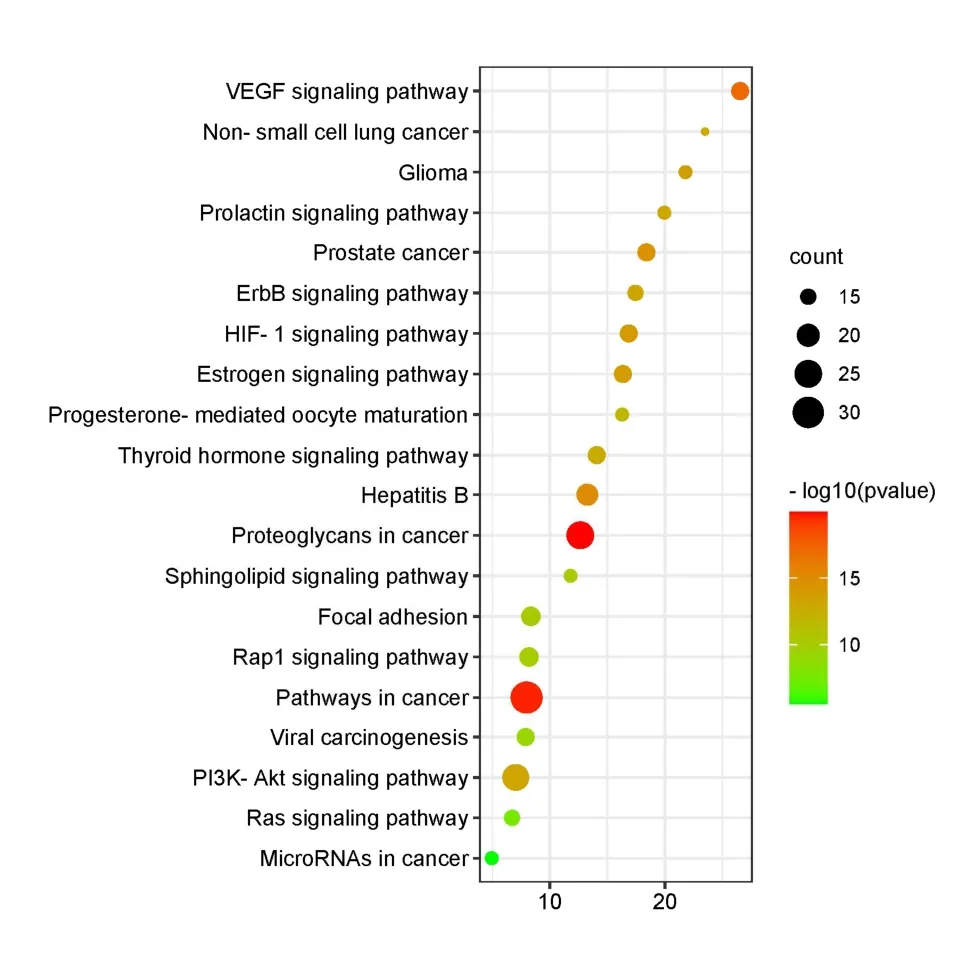
Figure 4.Bubble Diagram of Yiqifumai formulaheart failure common target by KEGG pathway enrichment.The color of the point represents the P value.
KEGG pathway enrichment based on key targets
The compound-disease common target was introduced into DAVID platform for KEGG pathway analysis for obtainment of 117 pathways.According to these target enrichment results and previous studies related to heart failure, more attention should be paid on PI3KAkt signaling pathway, HIF-1 signaling pathway, Rap1 signaling pathway, VEGF signaling pathway.Select the data with the top 20 gene enrichment results for visual processing and draw Bubble Diagram (Figure 4, Table S4).The color of the point represents thePvalue.
Discussion
Organism is a complex system with multi-level interactions.Many drugs act on multiple targets at the same timein vivo, rather than exert their efficacy through a single target.With the accelerated development of systems biology, multidirectional pharmacology, bioinformatics and other disciplines, network pharmacology, as the "next generation drug R&D mode", has emerged.Network pharmacology is based on the "disease gene target drug" interaction network to reveal the mystery of drug action in human body by systematically observing the impact of drugs on disease network [10].Its research method considering interaction, integrity and systematicness is completely consistent with the research methods of prescription medication, syndrome differentiation and treatment and holistic view of traditional Chinese medicine [11].In this study, the network pharmacological method was used to predict the active components of Yiqifumai formula, including schizandrin C, gomisin g, ginsenoside Rh2, Ruscogenin, etc., which mainly regulate 375 key targets of Yiqifumai formula in the treatment of heart failure, such as AKT1 and TNF, mainly involving PI3K Akt signaling pathway, HIF-1 signaling pathway, Rap1 signaling pathway VEGF signaling pathway, Ras signaling pathway, etc.
Schizandrin C and gomisin G are one of the main active components of Wuweizi.Schizandrin C has been proved to have significant anti-inflammatory and antioxidant effects, and gomisin G can inhibit cell proliferation [12-15].Ginsenoside Rh2 is one of the main active components of Hongshen, which has antiinflammatory and autophagy regulating activities [16-17].Ruscogenin is an index component of Maidong, which has significant immunomodulatory effect [18-19].It is confirmed from the side that the Chinese medicines composed of Yiqifumai formula play a role in the prevention and treatment of heart failure from different angles.Hypoxia inhibitory factor-1 can be detected in inflammatory diseases such as immune inflammation, bacterial infection, macrophage metabolism and virus infection α (hypoxia-inhibitory factor-1α, HIF-1α).Immune cells gather at the inflammatory site and are in a rapid hypoxia environment, which induces immune cells to transcribe HIF-1α.A large number of inflammatory signals, such as lipopolysaccharide, can enhance HIF gene transcription κB (nuclear factor Kappa B, NF-κB).It is a key immunomodulatory factor through positive regulation of downstream HIF-1α.Enhanced HIF-1 α.In inflammation, HIF-1 has the function of regulating immune cell survival and proinflammatory factor expression α.In the proinflammatory factor Interleukin-1β (Interleukin-1β, IL-1β).It plays a key role in the synthesis of HIF-1α.It is considered to be a key factor in inducing ejection fraction retention heart failure [20-21].
Among three GO categories, the top significantly enriched terms indicated that the therapeutic effects of Yiqifumai formula in protecting against heart failure may be involved in histone phosphorylation, the regulation of growth factor, regulation of receptor biosynthetic process, molecular function regulator, and RNA polymerase II transcription factor activity, histone kinase activity.The result of GO enrichment shows that BP contains negative regulation of receptor biological process, which contains PPARG (peroxisome proliferators activated receptors-G), a nuclear receptor in myocardial fibrosis of heart failure.Some studies [22-23] have shown that the increase of aldosterone in heart and circulation during heart failure can directly or indirectly lead to fibrosis.The effect of aldosterone on myocardial fibrosis is mainly combined with nuclear receptors, and the expression of nuclear receptors also increases significantly in heart failure.Therefore, the negative regulation of this process can treat heart failure by decreasing myocardial fibrosis.
An interesting phenomenon is that HIF-1 signaling pathway and VEGF signaling pathway, the key pathways of Yiqifumai formula in the treatment of heart failure, are important pathways for regulating angiogenesis.The GO analysis results also show the biological process of response to emotional growth factor, which suggests that angiogenesis plays an important role in the prevention and treatment of heart failure by Yiqifumai recipe.The research shows that the process of tube formation plays an important role in maintaining the stability of the cardiac environment [24].Specifically, myocardial hypertrophy is an adaptive response to physiological and pathological load.As a response to overload, a single cardiomyocyte mechanically stretches and activates intracellular hypertrophy signal pathway to reuse embryonic transcription factors and increase the synthesis of various proteins, such as structural and contractile proteins.These hypertrophy reactions increase oxygen demand and promote myocardial angiogenesis to dissolve oxygen relieve hypoxia and maintain cardiac systolic function.Continuous pathological load will lead to maladjustment and cardiac remodeling, leading to heart failure.It has confirmed the regulatory mechanism of angiogenesis in the pathophysiology of heart failure [25].Therefore, it is urgent to carry out indepth research to reveal the regulatory effect of Yiqifumai formula on angiogenesis in the prevention and treatment of heart failure.
Conclusion
To sum up, this manuscript applied network pharmacology to predict the main bioactive compounds and potential mechanisms of Yiqifumai formula on heart failure.Results showed that the bioactive compounds, such as Schizandrin C, Gomisin G, ginsenoside rh2, Ruscogenin and so on, in Yiqifumai formula can play the role of enhancing resistance via regulation of immune by intervention of Rap1 signaling pathway, Ras signaling pathway, HIF-1 signaling pathway, and eliminating pathogenic factors via regulation of angiogenesis by intervention of VEGF signaling pathway, HIF-1 signaling pathway.In conclusion, Yiqifumai formula exerts therapeutic effects by the mechanisms of “multi-target” and “enhancing resistance to eliminate pathogenic factors” in the treatment of heart failure.
Supplementary materials
Supplementary data are available online atTMR Modern Herbal Medicine.
杂志排行
TMR Modern Herbal Medicine的其它文章
- Guizhi-Fuling formula inhibits ovarian cancer progression by targeting STAT3 signaling network
- Differential expression of exosomal circRNAs and regulatory framework genes in myocardial infarction patients with cardiac remodeling in response to Tongguan Capsules
- Application of Chinese Herbal Medicine in the lnhibition of Salmonella and its virulence
- The clinical efficacy of traditional Chinese medicine in the auxiliary treatment of grade 1 hypertension: A systematic review and metaanalysis
- Experimental study on the effect of Huangqi and Danshen ultramicro gel on vascular healing of wound in rats based on network pharmacology
- lncreased macrophage inflammation response in pancreatic cancer patients with a diagnosis of Shi-Re
